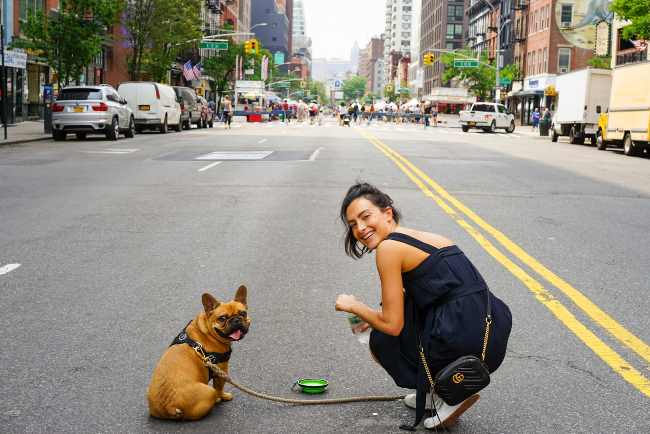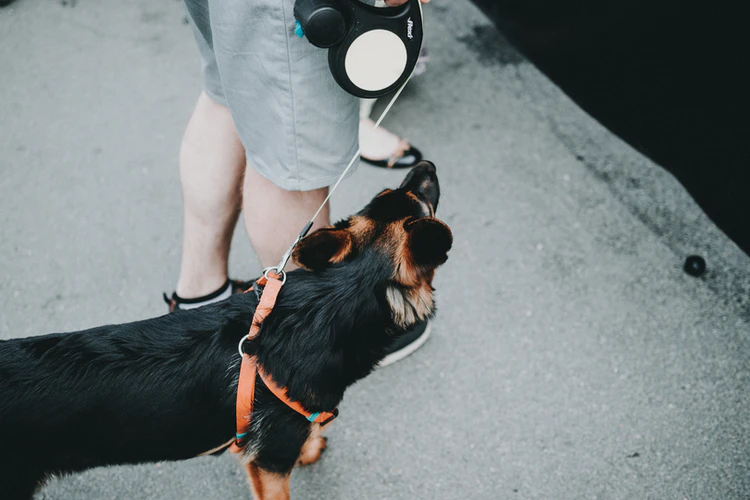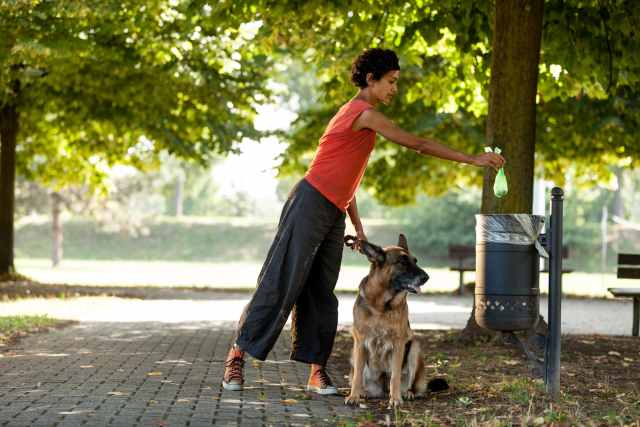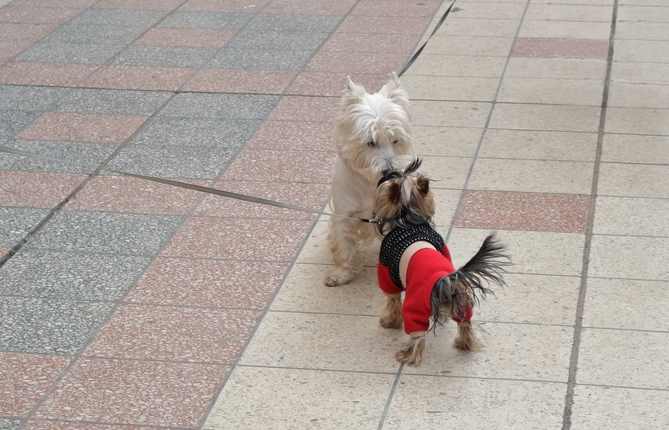- Small Dog Place Home
- Lifestyle
- City Dog Training
City Dog Training
5 Tips to Train Your Dog When You Live in the City
City Dog Training by Janice Jones |Updated 04-29-2024
For you and your furry friend to thrive and live a good life in a metropolitan area, you need to help your dog adapt to the big city life and train it accordingly.
With all the traffic lights, piercing sounds, crowded streets, people, and other dogs passing by, a dog is unable to run freely and it might find this to be disconcerting. Dogs can, unfortunately, develop behavioral issues and anxiety as a response to this and if left this way, neither will you as the dog’s owner nor the dog live a healthy and happy life in the city.
In the article below, we will give you some ideas and suggestions on how to train your pooch for a quality life in the big city.
Tips for City Dog Training

Image source: Megan Markham from Pexels
1. Teach Your Dog To Walk Calmly on Leash
Do you have a dog that pulls on the leash as soon as it's time for a walk around town? Don't worry as you are not the only one facing this common problem.
A peaceful walk on the streets and in the park can easily turn into a sweaty tug of war between the dog and the dog owner. This is why it is essential to train your pup to walk nicely with leash training.
In order for dogs to walk by our side with the leash loosely hanging, we must teach and train them since the dog's natural behavior is to be efficient and fight to reach its goal as quickly as possible.
The earlier you start leash training your pup, the better. Try some puppy training tips while they’re small because this is the time when they are like an open book, very receptive to learning.
When the dog pulls on the leash, it tightens around the neck. The dog wants to escape from the unpleasant feeling and pulls even more. When you use a harness, the pressure ends up further down, which feels better for the dog.
Go out with the dog in a harness before it has learned to walk calmly with a collar and leash. When the harness is on, there is no leash training. Bring the dog collar with you in your pocket and put it on if you want to practice walking nicely on a leash. Then the dog knows what is up - when the collar is on, it is forbidden to pull and when the harness is on you can both take a break from leash training.

Image source: Kevin Lehtla from Unsplash
2. Potty Training and Curbing Your Dog
When living in the big city with your
furry friend, potty training and curbing your dog are the greatest challenges
but also a must to not end up frustrated and exhausted as a dog owner.
Establish a strict potty schedule by taking your pooch outside to the same potty spot. With time, the dog will learn to hold it until it’s reached the very same location. In-house and balcony potty training is also necessary, especially for young puppies. Place puppy pads and indoor potty boxes as convenient potty training solutions.
When you live in an urban area, you’re bound to see many “Curb your dog” signs. It’s a way of showing respect and consideration of other people so that they don’t accidentally step in your pet’s pee or poo.
The way to teach this behavior is to softly steer the dog to the curb of the street. Since dogs are creatures of habit, when you repeat this multiple times, the dog will learn to finish its business quickly at the edge of the sidewalk.
Remember to always pick up after your dog. Always bring plastic bags and throw them away afterward in the nearest rubbish bin. There is nothing that causes as much irritation as dog poop on the street or used dog poop bags thrown on the ground.

3. Train Your Canine To Behave When It Meets Other Dogs
Living in a big city involves seeing and crossing paths with many other dogs, especially stray ones.
Through patience and consistency, you can train the dog's behavior so that dog meetings become somewhat relaxed and easy without all the barking and jumping.
If you have a puppy, it is good socialization training to let it meet other dogs - preferably of different breeds, sizes, and ages. This way, it learns to understand the "dog language" more easily.
Do not allow the dog to approach other dogs during your walks, otherwise, you'll have your hands full every time you’re roaming the streets.
When the dog is allowed to spend time with its dog friends, let it preferably be a place where they can be set loose. If you do not have access to such a place, practice a special routine that the dog must do first before it can approach another dog.
For example, have the dog stand by your side, and only when you say "go ahead" can the dog walk forward. If it moves before you allow it to, you should tell it to sit down.
This routine should be used every time the dog meets another dog, otherwise, it is not easy for the animal to understand what it can or cannot do.

4. Practise Elevator Etiquette
Being a city-dweller, you are bound to live in a building and elevators can be somewhat of a daunting experience for your furry companion.
The way to ease their fear and anxiety when taking the elevator is to start by standing at a distance from the elevator and command the dog to sit. When the elevator arrives and the doors open, tell it to enter the elevator while giving it a treat and showing affection.
That way the elevator will soon be associated with something positive. Once they get in, tell them once again to sit down as they will slowly but surely learn that this is not an area where they can run around and jump.
However, you should avoid escalators if the dog is not so small that you can carry it. The risk of the dog being injured in an escalator is otherwise great since it is very easy for paws or tails to get caught.
5. The Dos and Don'ts Of High-Rise Quality Living
As we mentioned before, the most affordable housing option when living in a city is an apartment building. Although challenging to find, a dog-friendly building is the obvious choice but keeping your dog under control and following the rules is crucial if you want to be a good neighbor to others.
Work the magic of dog commands and train your dog not to bark and run around the hallways and stay close to you while you’re inside the building. Make sure it’s also properly potty trained to avoid any unpleasant situations.
Not only will such training minimize the risks of the dog getting hurt if caught in an elevator door, but it will also show a sense of respect to your neighbors.
While inside your apartment, make sure that the windows and balcony doors are always shut if you’re not there to supervise your pooch.
Parting Thoughts
The relationship you and your dog have with each other should be a two-way street. Just like in any close relationship, the more you give, the more you receive. This is why you also play an important role in training your dog for living in the city.
Make sure you invest in your dog by preparing and training it for everything that a big city entails.
The process itself should be a rewarding and fun experience and allow your best friend to ease into the city’s bustling environment.
About Janice (author and voice behind this site)
Having lived with dogs and cats most of her life, Janice served as a veterinary technician for ten years in Maryland and twelve years as a Shih Tzu dog breeder in Ohio.
Her education includes undergraduate degrees in Psychology with a minor in biology, Early Childhood Education, and Nursing, and a master's in Mental Health Counseling.
She is a lifelong learner, a dog lover, and passionate about the welfare of animals. Her favorite breed for over 50 years has been the Shih Tzu, but she has also lived with Poodles, Maltese, Yorkshire Terriers, Beagles, English Bulldogs, Carin Terriers, and a Cocker Spaniel.
When not writing, reading, and researching dog-related topics, she likes to spend time with her eight Shih Tzu dogs, husband, and family, as well as knitting and crocheting. She is also the voice behind Miracle Shih Tzu and Smart-Knit-Crocheting
Does This Article Deserve Your Thumbs Up?
We always appreciate your support and encouragement. Your thumbs up means so much to us. Please like this article.
If you find this page or any page on Small Dog Place Helpful, or useful in anyway, I'd love it if you would click the small heart found on the bottom right of each page.
You can also share or bookmark this page -- just click on the:

Free Monthly Newsletter
Sign Up for Our Free Newsletter and get our Free Gift to You.
my E-book, The Top 10 Mistakes People Make When Choosing a Dog (and how to avoid them)

